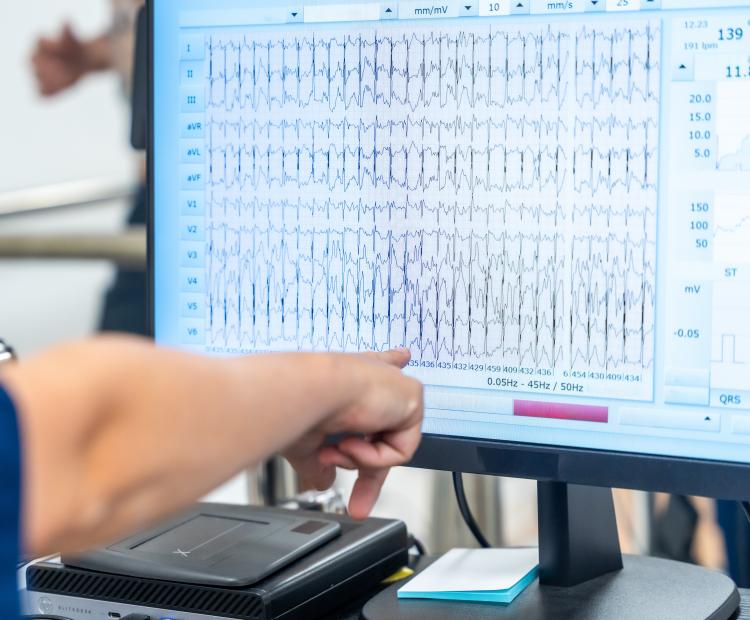Electromyography, or EMG for short, is a type of electrodiagnostic (EDX) test that uses needle electrodes to measure and detect electrical signals in your muscles and nerve cells.
The results of an EMG test can help your doctor determine if muscle weakness and numbness are due to a condition that affects the muscles, the nerves, or the signals between them.
Interpreting EMG test results can be complicated. For example, positive results from an EMG or NCV (another type of EDX test) do not indicate a specific diagnosis. Instead, they provide a piece of the puzzle and are a valuable diagnostic tool.
The guide below discusses why EMG tests are performed, how they can help determine muscle weakness, and what the results may mean.
.png)
What is the Purpose of an EMG Test?
EDX tests include two tests (NCV and EMG) to diagnose conditions related to muscle disorders, nerve damage, motor neuron diseases, peripheral nerve damage, and spinal cord damage.
An NCV is a type of nerve conduction study that measures the speed at which an electrical impulse moves through your nerves.
A physician may order an EMG test and NCV nerve conduction study if muscle or nerve disorder or injury symptoms appear. Symptoms which may require further investigation using an EMG test include the following:
- Muscle weakness
- Numbness
- Tingling
- Muscle loss
- Difficulty walking
- Balance problems
In many cases, multiple muscles are tested at one time. The location and number of muscles tested may depend on whether your healthcare provider suspects a specific condition.
The muscles' response during the test can also help identify certain muscle disorders and nerve damage. Conditions that may cause these issues that an EMG test helps diagnose include:
- Progressive muscle disorders that cause muscle weakness, such as muscular dystrophy.
- Neuromuscular disorders that affect the connections between the nerve and muscles, such as myasthenia gravis and amyotrophic lateral sclerosis (ALS), commonly referred to as Lou Gehrig's disease.
- Conditions that cause nerve damage, such as peripheral neuropathy, carpal tunnel syndrome, or pinched nerve.
EMGs and nerve conduction studies do not provide simple positive or negative results. A trained professional must review the results to determine exactly what they indicate.
Terms in an EDX Test Result
NCV and EMG test results include several key terms in the report that indicate conditions. Common terms include:
- Amplitude: This term refers to the heights of the electrical signal represented as a wave on an EMG test.
- Conduction velocity: The speed at which the electrical impulse travels across the nerve is called conduction velocity.
- Duration: Duration describes the width of an electrical wave.
- Conduction block: A conduction block refers to a decrease in the electrical signal as it crosses an anatomical structure.
- F reflex: This term refers to an electrical signal that travels up the spine and back along the same nerve fiber, providing a measure of conduction along the full length of a motor nerve. F reflexes are typically obtained from smaller muscles, like the hand or foot.
- H reflex: This term measures a spinal reflex involving sensory and motor fibers. The electrical impulse travels to the spinal cord from a sensory nerve and then back along a motor nerve.
Understanding Normal Muscle Activity
In EMG tests, muscle activity refers to the electrical signals generated during muscle movement. Typically, the stronger the muscle contraction, the greater the electrical activity. These electrical signals are reviewed after the test to determine the nature of the activity.
Normal muscle activity includes a sequence of events that combine to demonstrate “typical” behavior. It begins with a signal from motor neurons innervating the muscle fiber, resulting in a brief electrical burst.
Additionally, a series of physiological interactions occur to cause the release of certain neurotransmitters, which lead to muscle contraction. Muscle contraction usually stops when the nerve cell signaling ends.
During an EMG, a healthy muscle will not show electrical activity during rest. It should only indicate electrical activity when it contracts. However, if your muscle is damaged or does not receive the signals properly from the nerves, there may be abnormal electrical activity during rest.
Normal EMG Test Results
Normal EMG test results indicate that the nerves and muscles appear to be functioning normally, or as they should. If this is the case, additional testing may be conducted to determine the origin of certain symptoms.
Abnormal EMG Test Results
Abnormal EMG results, sometimes called positive EMG results, can reveal two types of issues.
First, abnormal electrical activity in resting muscles may suggest inflammation or muscle disease, which could cause spontaneous muscle twitching.
Second, abnormal activity during muscle contraction may appear as an irregularly sized or shaped wave on the EMG. This would indicate nerve issues affecting the muscles or muscle damage.
Remember that positive EMG test results may not pinpoint an exact diagnosis. An EMG test is only one piece of the diagnosis puzzle, but may help rule out certain conditions and narrow the possibilities.
Information Gained and How To Read EMG Test Results
Your physician will consider different categories of muscle activity when reading an EMG test, including the following.
- Muscle activity: Your doctor will review the test results and determine if your muscle turns on and off correctly. Normal muscle activity involves the muscle turning on when needed and turning off when not needed. If your EMG results show constant muscle activity, you may have a muscle spasticity problem.
- Timing: EMG results also help determine if your muscle is firing at the right time. The test allows your doctor to examine the timing of muscle activity during a movement, compare it to other muscles, and learn about the pattern of muscle activity to determine whether it is normal.
- Level: The EMG looks at the activity level of your muscle, or the level of effort the muscle must make during a movement, to determine if it is within normal limits.
- Comparison: The test will compare different muscle activity types. For example, two sides of the body can be compared to determine if muscle activity is the same.
- Fatigue: The test will also help determine how easily the muscle tires. This allows weak muscles to be identified and can be useful in determining whether a physical therapy program and strengthening exercises are helping.
When Will You Get Your EDX Results?
The results of an EMG test can be explored and discussed immediately. Depending on the test results, additional testing may be recommended to confirm a diagnosis.
After an EMG, the healthcare professional will provide instructions for recovery. Some patients may have mild muscle soreness at the needle insertion sites and may also experience bruising. The doctor will provide instructions on treating these side effects and any information on follow-up appointments that may be needed.
Summary
An EMG is a diagnostic test that evaluates nerve and muscle function. It is usually performed along with the nerve conduction study better to visualize the signals between your muscles and nerves. An EMG procedure can help determine the cause of symptoms such as muscle weakness, numbness, and tingling. However, interpretation of EMG test results requires a healthcare professional.
If you have any questions about EDX testing or symptoms related to muscle weakness or numbness, we are happy to help. If you would like to schedule a consultation, please contact us online or call 480-573-0130
today.
- Log in to post comments

